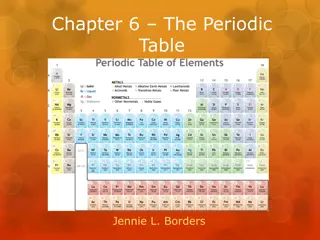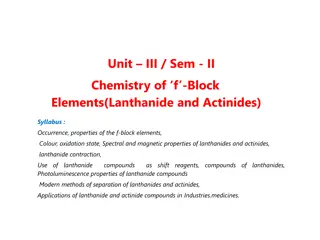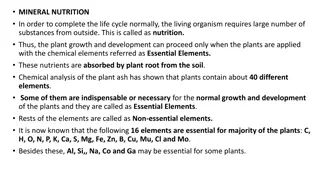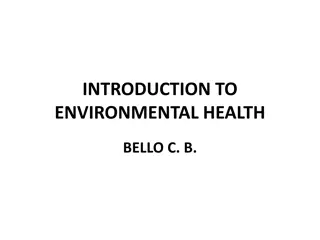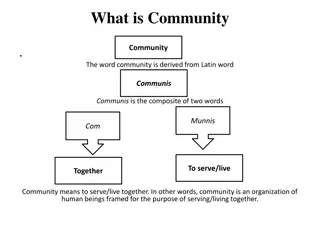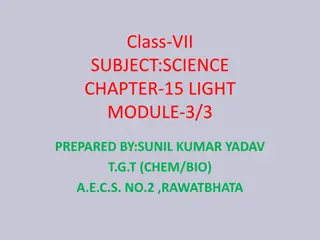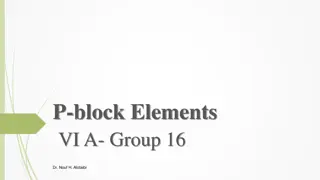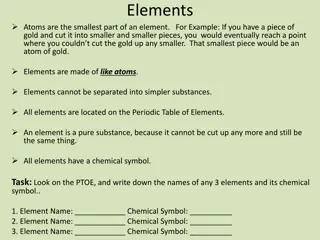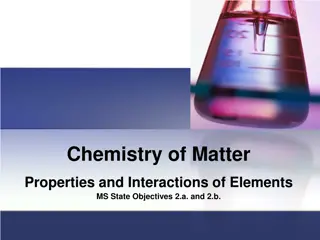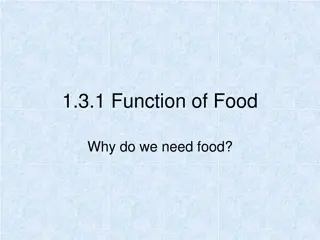Organometallic Compounds of Group 2 Elements
In the realm of organometallic chemistry, Group 2 elements, specifically alkaline earth metals like beryllium and magnesium, exhibit intriguing properties and reactivities. The chemistry of these elements, mimicking that of Group 12 elements in many aspects, leads to the formation of various organom
5 views • 27 slides
Understanding Medical Word Elements: Roots, Combining Forms, Suffixes, and Prefixes
Medical terminology uses word elements like roots, combining forms, suffixes, and prefixes. Word roots provide the main meaning, combining forms connect elements, suffixes modify word meaning, and prefixes are placed at the beginning of words. Examples illustrate how these elements are used in medic
5 views • 13 slides
Geology of the Earth
The evolution of elements in the universe began with the Big Bang, leading to the formation of hydrogen, helium, and heavier elements through stellar processes like fusion and supernovae. Our solar system formed 4.5 billion years ago from a nebula containing a variety of elements. These elements pla
4 views • 44 slides
Understanding the Periodic Table and Chemical Bonds in Physical Science
The periodic table organizes elements based on their properties, with rows representing periods and columns representing groups. Mendeleev's early table laid the foundation for predicting undiscovered elements. Today's periodic table orders elements by atomic number, showcasing the periodic law and
3 views • 15 slides
Understanding the Periodic Table: From Mendeleev to Modern Classification
Organizing elements based on their properties led to the development of the periodic table by Mendeleev with predictions that have stood the test of time. The modern periodic table arranges elements by increasing atomic number, showcasing repeating patterns of properties. It categorizes elements int
1 views • 29 slides
Chemistry of f-Block Elements: Lanthanide and Actinide Series Overview
This segment delves into the properties, occurrence, and unique characteristics of the f-block elements, focusing on the Lanthanide and Actinide series. Covering topics such as color, oxidation states, spectral properties, lanthanide contraction, separation methods, and industrial applications of th
1 views • 15 slides
Understanding the Key Elements of Tourism
Elements of tourism encompass crucial factors like pleasing weather, scenic attractions, historic and cultural sites, accessibility, amenities, and accommodation. These elements form the foundation of tourism activities worldwide, attracting visitors to destinations globally. From beautiful landscap
1 views • 13 slides
Essential Elements for Plant Growth: A Comprehensive Nutritional Guide
Plants require essential elements for normal growth and development, with 16 key elements identified as crucial. Macronutrients and micronutrients play vital roles in plant metabolism, with specific criteria determining the essentiality of each element. Understanding the diverse functions of these e
2 views • 17 slides
IEEE 802.11-20/0772r2 Multi-Link Elements Overview
IEEE 802.11-20/0772r2 discusses various aspects of multi-link elements in the context of IEEE 802.11 standards. The document covers the need for efficient element ID extension, different multi-link element structures, including authentication algorithms, common controls, and sub-elements organizatio
1 views • 10 slides
Understanding Environmental Health and Its Impact on Human Well-being
Environmental health is a critical aspect of public health that focuses on assessing, understanding, controlling, and improving the influence of the environment on people and vice versa. It encompasses factors such as workplace conditions, homes, communities, and various environmental elements like
0 views • 27 slides
Understanding the Concept of Community: Definition, Elements, and Significance
The concept of community is derived from the Latin word "Communis" and holds different definitions based on scholars' interpretations. It encompasses elements such as locality, we-feeling, security, norms and values, and roles and status within society. Communities are formed for the purpose of serv
0 views • 10 slides
Transport in the Phloem: A Detailed Overview by Ashish Sharma, Ph.D.
The phloem plays a vital role in transporting sugars and organic materials throughout plants. This system involves various specialized cells like sieve elements, companion cells, parenchyma cells, and phloem fibers. Mature sieve elements lack certain organelles and have non-lignified cell walls, mak
7 views • 32 slides
Understanding Light and Lenses: Exploring Colors and Images Formed
Explore the fascinating world of light and lenses in this module. Discover how lenses work, types of lenses like convex and concave, images formed by lenses, and the dispersion of sunlight into seven colors. Engage in activities showcasing the colors of sunlight and delve into the enchanting realm o
1 views • 10 slides
Classification of Elements and Periodicity in Properties: Overview and Evolution
The journey of understanding the classification of elements and periodicity in properties begins with early laws like the Law of Triads and Newland's Law of Octaves. Mendeleev's Periodic Law revolutionized the organization of elements, leading to the modern periodic table. Discoveries of eka-alumini
3 views • 32 slides
Evolution of Periodic Table and Classification of Elements
The Periodic Table is a systematic arrangement of elements based on atomic number and properties. Over time, chemists developed various classification methods such as Dobereiner's Triads, Newland's Law of Octaves, Mendeleev's Periodic Table, and the Modern Periodic Table to organize the increasing n
1 views • 26 slides
Overview of Group 16 P-Block Elements
Group 16 P-Block Elements, also known as Group VIA or Chalcogens, include oxygen, sulfur, selenium, tellurium, and polonium. These elements exhibit varying properties from non-metallic to semi-metallic to metallic. The group shows a general trend of increasing metallic properties down the group, alo
0 views • 26 slides
Understanding Atomic Structure, Elements, Mixtures, and Compounds
Exploring the basics of atomic structure, including elements, mixtures, and compounds. Learn about single atoms, molecules of elements, and compounds formed by different elements. Understand the relationship between protons, neutrons, electrons, atomic number, and atomic mass. Test your knowledge on
0 views • 6 slides
Understanding Nuclear Fusion and Fission in Atoms
Nuclear fusion is the process where two atomic nuclei combine, releasing energy and forming a new element. This process occurs in stars where hydrogen fuses to create heavier elements. On the other hand, nuclear fission involves the splitting of an atomic nucleus, releasing energy. Understanding the
3 views • 35 slides
D-Block Elements: Properties and Classification in Chemistry
Welcome to the Department of Chemistry at Kisan Veer Mahavidyalaya, Wai. Explore the Chemistry of Elements of the 3d series, focusing on d-Block Elements and Transition Elements. Learn about their electronic structure, colored ions, magnetic properties, oxidation states, and complex formation. Under
0 views • 34 slides
Insights into Coordination Chemistry Elements and Complexes
Transition elements with d or f electrons possess unique properties, play crucial roles in biological processes, and form colorful complexes with ligands. Occurring widely in nature, these elements have varied oxidation states and coordination numbers. Werner's formulation sheds light on primary and
0 views • 41 slides
Essential Elements of Clinical Trial Protocols
Understanding the key components of a clinical trial research protocol is essential for conducting successful studies. This includes identifying session objectives, discussing trial protocol contents, exploring observational study elements, and learning about reporting guidelines. Study objectives f
1 views • 25 slides
Understanding Mineral Nutrition in Plants
Mineral nutrition in plants involves the acquisition of essential elements in the form of inorganic ions from soil, followed by their absorption and utilization in various plant processes. Around 60 different elements have been reported in plants, with 30 being essential for plant growth. These esse
0 views • 39 slides
General Overview of p-Block Elements in Chemistry
p-block elements in the periodic table include metals, non-metals, metalloids, and noble gases from Group IIIA to Group VIIA. This group of elements has unique electronic configurations, properties, and characteristics, making them essential in understanding chemical behavior. The content discusses
0 views • 47 slides
Understanding Bioelements in Living Organisms
Bioelements are chemical elements crucial for the molecules in living organisms. They include major elements like oxygen, carbon, hydrogen, and trace elements such as iron, zinc. These elements play essential roles in maintaining growth, development, and health across different organisms. Understand
0 views • 9 slides
Fun Chemistry Activity: Meet the Elements
Engage in a fun and interactive chemistry activity where you watch a video to fill in chemical symbols and formulas of elements and compounds. This educational exercise involves identifying elements in everyday objects like rust, sugar, and propane. Learn about chemical formulas for common substance
0 views • 4 slides
Crystal Geometry Systems and Symmetry Elements
Crystal geometry involves the study of seven crystal systems defined by three symmetry elements - centre of symmetry, planes of symmetry, and axes of symmetry. These symmetry elements play crucial roles in determining the geometric properties of crystals. The centre of symmetry, plane of symmetry, a
0 views • 12 slides
Semantic Data Model of Electronic Invoicing Core Elements
Presentation by Fred van Blommestein on the EN16931-1 semantic data model of core elements in electronic invoicing, covering invoice processes, core invoice design, semantic model details, business rules, and invoicing principles. The model includes 160 elements in 33 groups, with mandatory elements
0 views • 13 slides
Understanding Chemistry: Elements, Molecules, Compounds, and Mixtures Flow Chart
In the world of chemistry, elements are the building blocks represented on the Periodic Table, while molecules and compounds are formed by atoms bonding together. Mixtures, on the other hand, involve a combination of substances without chemical bonding. Physical and chemical properties define matter
0 views • 7 slides
Understanding International Crimes: Elements, Definitions, and Evidence
International crimes encompass acts like crimes against humanity, war crimes, and genocide, with various legal elements to establish accountability. To substantiate such crimes, individuals must prove contextual, linkage, and specific elements. Evidence of sexual violence is crucial in proving these
1 views • 20 slides
Comparison between Array and Linked List Data Structures
Linked lists and arrays are commonly used data structures in programming. Linked lists offer flexibility in size changes and efficient rearrangement of elements, while arrays provide direct access to elements based on their index. Linked lists involve pointers connecting elements, allowing for dynam
0 views • 24 slides
Understanding Compounds and Elements through Experiments
Explore the world of compounds and elements through engaging experiments involving magnesium, oxygen, and more. Learn about the energy released when elements combine, naming conventions for various compounds, and the significance of oxygen in compound naming. Discover essential elements and their sy
0 views • 10 slides
Understanding Syntax and Translation in Logic
Explore the world of syntax and translation in logic through topics such as forming well-formed formulas, identifying main connectives, De Morgan's Laws, Venn diagrams, necessary and sufficient conditions, and more. Discover the language of logic, vocabulary, truth-functional connectives, punctuatio
0 views • 46 slides
Exploring the World of Matter and Elements
Matter is the physical "stuff" of the universe, encompassing elements that make up rocks, wood, air, metals, water, and living organisms. Chemical elements are the building blocks of matter, with essential elements like oxygen, carbon, hydrogen, and nitrogen constituting a significant part of living
0 views • 24 slides
Understanding Career Education Data Elements
Explore the essential data elements in career education such as Work-Based Learning, Industry-Recognized Credentials, Advanced Opportunities, Dual Enrollment, and Arts. Learn how these elements are utilized in reporting, data tracking, and program development. Discover the role of the CTE Data Team
0 views • 19 slides
Understanding Chemistry: Elements, Periodic Table, and Interactions
Delve into the world of chemistry, exploring the fundamental concepts of elements, the development of the periodic table by scientists like Mendeleev and Moseley, and how elements interact with each other. Discover the properties of elements, atomic structures, and the organization of the periodic t
0 views • 31 slides
Understanding the Essential Functions of Food in Our Body
The function of food is crucial for our existence, providing energy for bodily functions, supporting growth and repair of cells, tissues, and organs, and supplying materials for metabolism and continuity of life. Chemical elements in food play a vital role, with six common elements, salts, and trace
1 views • 53 slides
Understanding S-Block Elements in the Periodic Table
The s-block elements in the Periodic Table consist of 14 elements with unique properties and characteristics. Lithium, sodium, and potassium are notable members of Group 1, characterized by their reactivity and ability to form alkaline solutions when in contact with water. These soft metals exhibit
0 views • 23 slides
Aerobic Gymnastics Competition Guidelines and Rules
The guidelines for aerobic gymnastics competitions include compulsory elements, categories, competition spaces, deductions, and specific rules for different age groups. The competitions have specific parameters for elements allowed, lifting, floor elements, music length, maximum difficulty elements,
0 views • 17 slides
Understanding Standard Molar Enthalpies of Formation
Formation reactions involve substances being created from elements in their standard states, with the enthalpy change known as the standard molar enthalpy of formation (Hf). This enthalpy represents the energy released or absorbed when one mole of a compound is formed from its elements in their stan
0 views • 13 slides
Understanding Blood: Composition and Functions
Blood is a vital fluid tissue in the human body, classified as a connective tissue. It consists of living cells known as formed elements suspended in a non-living matrix called plasma. The physical characteristics of blood, such as color range, pH level, and temperature, play crucial roles in mainta
0 views • 33 slides




